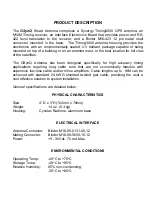
voltage should be increased to allow for the extra IR drop in the cable.
The GSynQ utilizes a high efficiency switching regulator to keep self heating to a
minimum (important in high ambient temperature environments.) At +9Vdc input
voltage the GSynQ draws approximately 65mA, while at +30Vdc the current draw
drops to a little under 20mA.
In the event that the GSynQ is accidentally over-voltaged a self-resetting polymer
fuse in the antenna opens, protecting the GSynQ antenna from possible damage.
Once tripped, the fuse should be allowed to cool for several minutes before power is
reapplied.
OPERATION
Operation of the GSynQ antenna is straight forward. For operational details of the
M12M receiver contained in the GSynQ
the user is referred to the M12M User’s
Guide available at www.synergy-gps.com (Tech Support-Users Guides-iLotus).
Basic setup details are as follows:
1 -
Connect the antenna to the User System via user cable or Synergy System
cable. If the User System does not have an RS422 input then a Synergy
Systems Interface Unit can be used for interfacing to RS232 port or USB port.
2 -
Apply
power.
3 -
Send the M12M receiver the desired initialization commands using SiRF
Oncore software, SynTAC, or other custom software.
Software—
Windows based software to communicate with the GSynQ is available
on the Synergy Systems website-www.Synergy-gps.com.
The SiRF Oncore
program is a free download that may be accessed from the home
page. An evaluation copy of Synergy’s
SynTaC
software is available from the
Technical Support
page of the website. Please refer to the ILotus M12M GPS
Receiver User’s Guide for details on operation of the M12M contained in the GSynQ
antenna.
1PPS Offset -
Unlike GPS systems with short cabling systems, the interface cable
and RS422 drivers can introduce an appreciable offset that should be compensated
for. The MAX3488 RS422 driver in the GSynQ antenna has a typical propagation
delay of approximately 900nS and twisted pair cables such as those used for the
interface cable typically have delays on the order of 170nS per 100 ft (~31m).

























